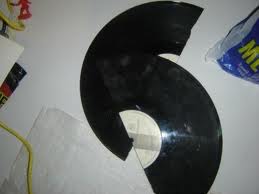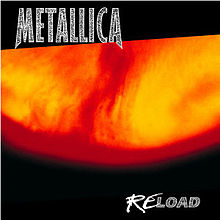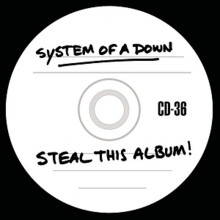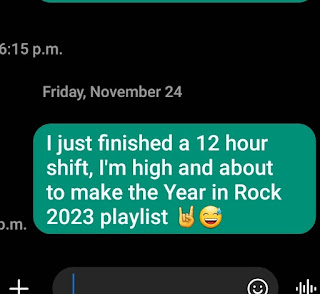Hear Me Out: Rise Of The Rationed Album, Part 1
Ah, the
double album. The ultimate artistic statement. When your vision
absolutely, positively cannot be confined to the restraints of a
single platter. Over the years, we've seen countless artists try to
tiptoe down this slippery slope, and only a few have made it to the
bottom without grass stains on the ass of their jeans.
The double
album's meaning has been warped and twisted so many times in the last
half century that it's often confusing when trying to determine what
counts as a double album or not. When the compact disc raised the
maximum length on one disc, many double albums technically became
single albums; likewise, many single albums recorded since are so
long that they would have undoubtedly been doubles in the original
vinyl age.
With the
albums on this list, though, it's not necessary to bicker over the
rules. These albums aren't like the others.
You may
have noticed an emerging trend in music; I most definitely have. This
fall, several artists are releasing new albums; that goes without
saying. But, take a closer look at the upcoming releases from Green
Day, Down, Stone Sour, and Coheed and Cambria. These four bands have
all decided that they have more to say than can fit on a single
album. And all four have decided that, rather than throw everything
at their fans at once, they should dole their vision out
periodically. Green Day is releasing three albums worth of material
between September and January, while Stone Sour and Coheed are
splitting their double albums down the middle and spacing the halves'
releases six months apart. Meanwhile, Down is planning to release
their fourth album as four EPs over the coming months and/or years.
Not to mention Red Hot Chili Peppers, who have taken 18 songs that
weren't good enough for I'm With You and set out to release them
serially as a series of nine 7” singles during the course of the
rest of the year.
With so
many bands employing this strategy at once, it got me thinking about
the ones who've done it before. If it seems like an extraordinarily
high amount of serial releases, it's because it hasn't happened all
that often before. Take double albums being released separately as
two albums on the same day (see Guns N' Roses, Bruce Springsteen, Tom
Waits) out of the equation and you'll see that there have been only
slightly more serialized releases over the past fifteen years than
there are slated for release this fall.
We'll get
around to what that might mean later. First, here's a handful of
examples of serially released double albums from history and why they
did (and didn't) work:

Metallica:
Load/Reload
There are
earlier examples of double albums split into separate releases, with
the highest profile of them being Guns N' Roses' Use Your Illusion
albums in 1991. And, if you want to get technical, Load and Reload
weren't completely recorded during the exact same sessions. However,
these two albums, released seventeen months apart in 1996-97, were
originally conceived as a double album. All 27 songs were written for
the most part but, rather than finish everything and make their fans
wait even longer for new material (at the time of Load's release it
had been close to five years since their 1991 self titled album, an
unprecedented wait for Metallica fans at the time), they chose to
fill one album to its maximum allowance and release it to quell
anticipation while they finished up the rest (at 78:59, Load boasts
the absolute maximum running time for a compact disc without
potential quality problems; The Outlaw Torn actually had to be edited
for inclusion).
With fans
as restless as they were, splitting the two halves also guaranteed
there wouldn't be an abnormally long wait between releases. Of
course, we all know now that after Reload, fans had to suffer through
nearly six years waiting for the official follow-up (and many testify
that the suffering started long before Load and hasn't stopped since,
but that's a whole other story).
Another
benefit of the staggered release was that fans would have had to
digest some 155 minutes of new material at once had they chose to go
ahead with the original plan. Load and Reload already boast a glut of
good songs that have been overlooked thanks to them being drops in
the Load bucket (okay, that was a little gross and unintentional);
you never hear people talk about Bleeding Me or Where The Wild Things
Are when discussing Metallica's finer moments, and that's shameful.
Now we're
getting to the core of where Load and Reload failed Metallica and,
generally, where double albums almost always fail their makers. With
so much material, it's a herculean task to take anything substantial
from it as a listener; over time, we'll pick out our favourites,
sure. But, to absorb such a massive tracklist and not take exception
with the inclusion of some of those songs is an impossible favour for
a band to ask of their fans. Without a connecting narrative or
otherwise proper sense of flow, most double albums are nothing more
than a bunch of wet noodles being thrown at a wall, leaving it up to
the listener which ones stick.
Load and
Reload have had to saddle a lot of disdain; part of it is due to the
massive risk Metallica took in straying from their thrash roots,
while much of it has been heaped on retroactively through the benefit
of a new generation of haters' hindsight. But, at the time, they were
coldly calculated and boldly executed experiments, and ones that I
can't fault them for undertaking.
Following
up an all-time watermark album like OK Computer must have driven
Radiohead bonkers. Thom Yorke developed severe depression in its
wake, and the band nearly called it quits. However, with more to say,
they soldiered on. Coming in October of 2000, Kid A turned everything
on its head just like OK Computer had done three years prior. Its
heavy electronic tension and drastically scaled back guitars marked
another in Radiohead's long line of evolutions, and ushered in a new
piece of gristle for the mainstream to gnash its teeth upon. It was
also a bitterly divisive album among fans who couldn't determine
whether the new direction was born of brilliance or lunacy.
It was
seemingly divisive for the band as well, as nine months later
Amnesiac was released, an album comprised of additional songs from
the same recording sessions. Placing Kid A at the musical centre of
the puzzle, Amnesiac skirted its artistic edges. Traditional
instrumentation was more prevalent on some tracks, particularly the
piano and drum jazz fusion beauty Pyramid Song and guitar-driven
pleasers I Might Be Wrong and Knives Out. But, it also went to
bizarre places even Kid A wouldn't go, like the swirling
industro-alien nightmare Pulk/Pull Revolving Doors and backmasked
panic soundtrack Like Spinning Plates.
Without Kid A as a point of comparison, Amnesiac is a sprawling mess of sounds.
Its diversity plots against it, making it an uneven affair that's
nearly impossible to enjoy front-to-back, even amongst fans. However,
when supplemented with Kid A, one can more fully appreciate the scope
of what Radiohead was trying to accomplish in the recording sessions
that yielded these albums. Would it have worked better as a proper,
simultaneously released double album? Again, there's the abundance of
songs to consider; it may have been commercial suicide to ask fans to
take in all 21 songs at once. However, as is the case with most
albums that grow too big for their britches, the best songs on Kid A
and Amnesiac rank up there with Radiohead's finest moments, even OK
Computer.
This entry
is unique to the list in that the latter half was presumably never
intended to be released. Toxicity was a big time breakthrough for
System Of A Down, going multi-platinum and propelling their oddball
nu-metal to the rock stratosphere following its September 2001
release. As is the case with a majority of bands, a wealth of
additional songs were recorded during the Toxicity sessions but not
included on the album. The story could have ended there, but with
internet leaks becoming increasingly common, we all know that it
didn't.
When an
album's worth of unreleased demos was leaked in late 2001 under the
title Toxicity II, S.O.A.D. were understandably upset. Not only were
fans listening to songs they hadn't intended on releasing, they were
listening to unfinished, poor-quality versions of them. So, they went
back to the studio, finished the songs (while adding a few that
hadn't been leaked), and released it as Steal This Album! in November
2002.
Though
officially recognized as their third album, the general consensus is
that Steal This Album! is simply a counterpart to Toxicity by most fans,
considering the leak and the fact that the bulk of its songs were
demoed during the Toxicity sessions. And, even if they prefer to keep
them separated, I have to admit that pairing the two albums together
makes for a surprisingly solid double album. Are there clunkers?
Absolutely. Still, the consistency of the tracks is of benefit to the
piece, and fans have been cherry picking their favourites and
creating superalbums out of them for a decade and running.
Plus, the
band learned a valuable lesson from the experience of these two
albums, which leads to...
Having
already had their hand forced with Toxicity, System Of A Down decided
to cut the leakers off at the pass when recording what was, in
earnest, the follow-up to Toxicity. So, in 2005, they announced that
their next album would be a double split into two parts (despite the
fact that both albums' running time combined would not only fit on one disc
but still be shorter than Load after doing so), with Mezmerize releasing in May and
Hypnotize following six months later.
When
Mezmerize hit the shelves, I was working at a record store, and I
remember it as being one of the last event releases. By which I mean,
people came out in droves for it, and it felt like much more than
simply a new album. Listening to Mezmerize today, it's hard to
imagine it as an overwhelming mainstream smash if you weren't there,
but it was. To its credit, the album was top-notch; hardly a dud on
it, Mezmerize plays like a speeding car on an icy road, threatening
to crash and burn at any given moment but gleefully skidding along
with no regard for its safety or the safety of its' listeners' ears.
But,
something funny happened on the way to Hypnotize. In the short six
month span between the releases, a lot of folks got offended, bored,
burned out on the band or a combination of all three. Hypnotize sold
well, but not as well as Mezmerize. To be sure, it was still a
multi-platinum bona fide hit, but the same magic wasn't there.
Hypnotize's release wasn't treated like an equally important event to
Mezmerize; perhaps fans assumed it was comprised not of the second
half of the album, but rather the songs that weren't good enough for
the first.
Whatever
the case, Hypnotize doesn't give off the same mojo that Mezmerize
does; there's nothing as joyfully incendiary as B.Y.O.B., nor a song
with the same irresistible combination of ugly and beauty as
Question! There are fantastic songs on display, such as the powerful
behemoth Holy Mountains and the deliriously odd Vicinity of
Obscenity. It just doesn't have the same consistency of Mezmerize,
and I can't help but feel that these two albums would have been
better served as a singular epic piece of, say, 16 songs with the
other seven left off the proceedings and used as B-sides.
So, no,
splitting recording sessions into multiple releases is nothing new.
It's simply a case of many artists choosing this method over a short
period of time. But one has to ask; why, and why now?
We'll talk
about that in Part 2.











Comments
Post a Comment